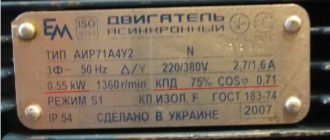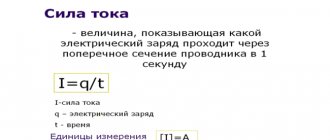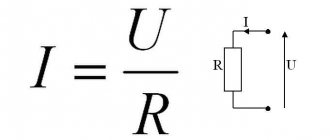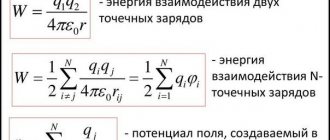The session is approaching, and it’s time for us to move from theory to practice. Over the weekend we sat down and thought that many students would benefit from having a collection of basic physics formulas at their fingertips. Dry formulas with explanation: short, concise, nothing superfluous. A very useful thing when solving problems, you know. And during an exam, when exactly what was memorized the day before might “jump out of your head,” such a selection will serve an excellent purpose.
The most problems are usually asked in the three most popular sections of physics. These are mechanics , thermodynamics and molecular physics , electricity . Let's take them!
Daily newsletter with useful information for students of all directions - on our telegram channel.
Kinematics
To the table of contents...
Path with uniform motion:
The displacement S (the straight line distance between the starting and ending points of movement) is usually found from geometric considerations. The coordinate during uniform rectilinear motion changes according to the law (similar equations are obtained for the remaining coordinate axes):
Average travel speed:
Average moving speed:
Determination of acceleration during uniformly accelerated motion:
Having expressed the final speed from the formula above, we obtain a more common form of the previous formula, which now expresses the dependence of speed on time for uniformly accelerated motion:
Average speed for uniformly accelerated motion:
Displacement during uniformly accelerated linear motion can be calculated using several formulas:
The coordinate during uniformly accelerated motion changes according to the law:
The projection of velocity during uniformly accelerated motion changes according to the following law:
The speed with which a body falling from a height h without an initial speed will fall:
Time of falling of a body from a height h without initial speed:
The maximum height to which a body thrown vertically upward with an initial speed v0 will rise, the time it takes for this body to rise to the maximum height, and the total flight time (before returning to the starting point):
Formula for body braking distance:
The time a body falls during a horizontal throw from a height H can be found by the formula:
Body flight range for a horizontal throw from a height H:
Full speed at an arbitrary moment in time with a horizontal throw, and the angle of inclination of the speed to the horizon:
Maximum lift height when throwing at an angle to the horizontal (relative to the initial level):
Time to rise to maximum height when throwing at an angle to the horizontal:
Flight range and total flight time of a body thrown at an angle to the horizon (provided that the flight ends at the same altitude from which it began, i.e. the body was thrown, for example, from ground to ground):
Determination of the rotation period for uniform circular motion:
Determination of rotation speed for uniform circular motion:
Relationship between period and frequency:
Linear speed for uniform circular motion can be found using the formulas:
Angular speed of rotation during uniform circular motion:
The relationship between linear velocity and angular velocity is expressed by the formula:
The relationship between the angle of rotation and the path for uniform motion in a circle of radius R (in fact, this is just a formula for the arc length from geometry):
Centripetal acceleration is found using one of the formulas:
Dynamics
To the table of contents...
Newton's second law:
Here: F is the resultant force, which is equal to the sum of all forces acting on the body:
Newton's second law in projections on the axis (this form of notation is most often used in practice):
Newton's third law (action force equals reaction force):
Elastic force:
The overall stiffness coefficient of parallel connected springs is:
The overall stiffness coefficient of series-connected springs is:
Sliding friction force (or maximum value of static friction force):
Law of universal gravitation:
If we consider a body on the surface of the planet and introduce the following notation:
Where: g is the acceleration of gravity on the surface of a given planet, we obtain the following formula for gravity:
The acceleration of free fall at a certain height from the surface of the planet is expressed by the formula:
Speed of the satellite in a circular orbit:
First escape velocity:
Kepler's law for the periods of revolution of two bodies rotating around one attractive center:
Hydrostatics
To the table of contents...
The definition of pressure is given by the following formula:
The pressure created by the liquid column is determined by the formula:
But often it is also necessary to take into account atmospheric pressure, then the formula for the total pressure at a certain depth h in the liquid takes the form:
Ideal hydraulic press:
Any hydraulic press:
Efficiency for a non-ideal hydraulic press:
Archimedes' force (buoyancy force, V - volume of the immersed part of the body):
Measuring instruments
Measuring instruments are used to measure the parameters of electrical circuits:
- Voltmeter;
- Ammeter;
- Ohmmeter.
The most commonly used class of combined devices in which the measured value is selected by a switch is ampere-volt-ohmmeters or avometers.
One of the most common avometers
Pulse
To the table of contents...
The momentum of the body is found by the following formula:
Change in the momentum of a body or system of bodies (note that the difference between the final and initial impulses is vector):
The total impulse of the system of bodies (the important thing is that the sum is vector):
Newton's second law in momentum form can be written as the following formula:
Law of conservation of momentum. As follows from the previous formula, if there is no external force acting on a system of bodies, or the action of external forces is compensated (the resultant force is zero), then the change in momentum is zero, which means that the total momentum of the system is conserved:
If external forces do not act only along one of the axes, then the projection of the momentum onto this axis is preserved, for example:
Work, power, energy
To the table of contents...
Mechanical work is calculated using the following formula:
The most general formula for power (if the power is variable, then the average power is calculated using the following formula):
Instant mechanical power:
The efficiency factor (efficiency) can be calculated both through power and through work:
Formula for kinetic energy:
Potential energy of a body raised to a height:
Potential energy of a stretched (or compressed) spring:
Total mechanical energy:
Relationship between the total mechanical energy of a body or system of bodies and the work of external forces:
Law of conservation of mechanical energy (hereinafter – LSE). As follows from the previous formula, if external forces do not do work on a body (or system of bodies), then its (their) total total mechanical energy remains constant, while energy can flow from one type to another (from kinetic to potential or vice versa) :
Where Coulomb's law is applied in practice
The fundamental law of electrostatics is the most important discovery of Charles Coulomb, which has found its application in many fields.
The works of the famous physicist were used in the process of inventing various devices, instruments, apparatus. For example, a lightning rod.
With the help of a lightning rod, residential buildings and buildings are protected from lightning strikes during a thunderstorm. Thus, the degree of protection of electrical equipment is increased.
A lightning rod works on the following principle: during a thunderstorm, strong inductive charges gradually begin to accumulate on the ground, which rise upward and are attracted to the clouds. In this case, a rather large electric field is formed on the ground. Near the lightning rod, the electric field becomes stronger, due to which a corona electric charge is ignited from the tip of the device.
Next, the charge formed on the ground begins to be attracted to the charge of the cloud with the opposite sign, as it should be according to Charles Coulomb’s law. After this, the air undergoes an ionization process, and the electric field strength becomes less near the end of the lightning rod. Thus, the risk of lightning striking the building is minimal.
Note! If a building on which a lightning rod is installed is struck, then a fire will not occur, and all the energy will go into the ground.
Based on Coulomb's law, a device called the “Particle Accelerator” was developed, which is in great demand today.
This device creates a strong electric field, which increases the energy of particles entering it.
Molecular physics
To the table of contents...
The chemical amount of a substance is found according to one of the formulas:
The mass of one molecule of a substance can be found using the following formula:
Relationship between mass, density and volume:
The basic equation of the molecular kinetic theory (MKT) of an ideal gas:
The definition of concentration is given by the following formula:
There are two formulas for the root mean square speed of molecules:
Average kinetic energy of translational motion of one molecule:
Boltzmann's constant, Avogadro's constant and the universal gas constant are related as follows:
Corollaries from the basic MKT equation:
Equation of state of an ideal gas (Clapeyron-Mendeleev equation):
Gas laws. Boyle-Marriott Law:
Gay-Lussac's Law:
Charles's Law:
Universal gas law (Clapeyron):
Pressure of a mixture of gases (Dalton's law):
Thermal expansion of bodies. The thermal expansion of gases is described by Gay-Lussac's law. The thermal expansion of liquids obeys the following law:
For the expansion of solids, three formulas are used to describe the change in the linear dimensions, area and volume of the body:
Thermodynamics
To the table of contents...
The amount of heat (energy) required to heat a certain body (or the amount of heat released when the body cools) is calculated by the formula:
The heat capacity (C - large) of a body can be calculated through the specific heat capacity (c - small) of the substance and the mass of the body using the following formula:
Then the formula for the amount of heat necessary to heat the body, or released when the body cools, can be rewritten as follows:
Phase transformations. During vaporization it is absorbed and during condensation an amount of heat is released equal to:
During melting it is absorbed, and during crystallization an amount of heat is released equal to:
When fuel burns, an amount of heat is released equal to:
Heat balance equation (HBE). For a closed system of bodies, the following holds (the sum of heat given is equal to the sum of heat received):
If all heat is written taking into account the sign, where “+” corresponds to the receipt of energy by the body, and “–” to the release, then this equation can be written in the form:
Ideal gas work:
If the gas pressure changes, then the work done by the gas is calculated as the area of the figure under the graph in p–V coordinates. Internal energy of an ideal monatomic gas:
The change in internal energy is calculated using the formula:
First law (first law) of thermodynamics (FLE):
For various isoprocesses, formulas can be written by which the resulting heat Q, the change in internal energy ΔU and the gas work A can be calculated. Isochoric process (V = const):
Isobaric process (p = const):
Isothermal process (T = const):
Adiabatic process (Q = 0):
The efficiency of a heat engine can be calculated using the formula:
Where: Q1 is the amount of heat received by the working fluid in one cycle from the heater, Q2 is the amount of heat transferred by the working fluid to the refrigerator in one cycle. Work done by a heat engine in one cycle:
The highest efficiency at given temperatures of the heater T1 and refrigerator T2 is achieved if the heat engine operates according to the Carnot cycle. This Carnot cycle efficiency is equal to:
Absolute humidity is calculated as water vapor density (from the Clapeyron-Mendeleev equation the ratio of mass to volume is expressed and the following formula is obtained):
Relative air humidity can be calculated using the following formulas:
Potential energy of a liquid surface with area S:
The surface tension force acting on a section of the liquid boundary of length L:
Height of the liquid column in the capillary:
With complete wetting θ = 0°, cos θ = 1. In this case, the height of the liquid column in the capillary will be equal to:
With complete non-wetting, θ = 180°, cos θ = –1 and, therefore, h < 0. The level of the non-wetting liquid in the capillary drops below the level of the liquid in the vessel into which the capillary is lowered.
Hydraulic analogy
To make it easier to understand the laws of electrical circuits, you can imagine an analogy with a hydraulic system, in which the connection of the pump and pipelines forms a closed system. To do this, the following correspondences are needed:
- Power source – pump;
- Conductors – pipes;
- Electric current is the movement of water.
Without much effort, it becomes clearer that the smaller the diameter of the pipes, the slower the water moves through them. The more powerful the pump, the more water it can pump. With the same pump power, reducing the diameter of the pipes will lead to a decrease in water flow.
Hydraulic analogy
Electrostatics
To the table of contents...
Electric charge can be found using the formula:
Linear charge density:
Surface charge density:
Volumetric charge density:
Coulomb's law (the force of electrostatic interaction between two electric charges):
Where: k is a certain constant electrostatic coefficient, which is determined as follows:
The electric field strength is found by the formula (although more often this formula is used to find the force acting on a charge in a given electric field):
Superposition principle for electric fields (the resulting electric field is equal to the vector sum of the electric fields of its components):
The electric field strength created by a charge Q at a distance r from its center:
Electric field strength created by a charged plane:
The potential energy of interaction of two electric charges is expressed by the formula:
Electrical voltage is simply a potential difference, i.e. The definition of electrical voltage can be given by the formula:
In a uniform electric field there is a relationship between field strength and voltage:
The work of the electric field can be calculated as the difference between the initial and final potential energy of the system of charges:
The work of the electric field in the general case can also be calculated using one of the formulas:
In a uniform field, when a charge moves along its field lines, the work of the field can also be calculated using the following formula:
The definition of potential is given by the expression:
The potential that a point charge or charged sphere creates:
Superposition principle for electric potential (the resulting potential is equal to the scalar sum of the potentials of the fields that make up the resulting field):
For the dielectric constant of a substance, the following is true:
The definition of electrical capacitance is given by the formula:
Capacitance of parallel plate capacitor:
Capacitor charge:
Electric field strength inside a parallel-plate capacitor:
The force of attraction of the plates of a flat capacitor:
Capacitor energy (generally speaking, this is the energy of the electric field inside the capacitor):
Volumetric electric field energy density:
What is electric charge q
Electric charge, denoted in the international system of units by the letters q and Q, is considered a scalar physical quantity that determines the property of a particle or body to act as a source of an electromagnetic field and enter into direct interaction with it. In physics, there are several types of electromagnetic charged particles, and they are called positive or negative. Both units are measured in Coulombs, and can be found by calculating the product of one Ampere and one second.
Concept from the textbook
Electricity
To the table of contents...
The current strength can be found using the formula:
Current Density:
Conductor resistance:
The dependence of conductor resistance on temperature is given by the following formula:
Ohm's law (expresses the dependence of current on electrical voltage and resistance):
Patterns of serial connection:
Patterns of parallel connection:
The electromotive force of the current source (EMF) is determined using the following formula:
Ohm's law for a complete circuit:
The voltage drop in the external circuit is equal to (it is also called the voltage at the source terminals):
Short circuit current:
Work of electric current (Joule-Lenz law). Work A of an electric current flowing through a conductor with resistance is converted into heat Q released on the conductor:
Electric current power:
Closed circuit energy balance
Net power or power released in the external circuit:
The maximum possible useful power of the source is achieved if R = r and is equal to:
If, when different resistances R1 and R2 are connected to the same current source, equal powers are allocated to them, then the internal resistance of this current source can be found using the formula:
Power loss or power inside the current source:
Total power developed by the current source:
Current source efficiency:
Electrolysis
The mass m of the substance released on the electrode is directly proportional to the charge Q passing through the electrolyte:
The value of k is called the electrochemical equivalent. It can be calculated using the formula:
Where: n is the valency of the substance, NA is Avogadro’s constant, M is the molar mass of the substance, e is the elementary charge. Sometimes the following notation for Faraday's constant is also introduced:
How to calculate using laws
Since q and Q are scalar units, they can be calculated using the laws through exact formulas derived by famous physicists. For example, in accordance with Coulomb's law, it is possible to find the magnitude and force direction of the interaction of charged particles between several stationary bodies.
You may be interested in: Features of DC power
Conservation Law
All elementary particles are divided into neutral or charged. They interact with each other within an electromagnetic field. Particles that have the same electron repel, and opposite electrons attract. In the first case, there is an excess of electrons, and in the second, a lack of electrons. Both types of particles are charged through electrification. In practice, when this phenomenon occurs, the charged particles are equal in magnitude, despite the opposite signs. When different particles attract, electrification and electron conservation occurs between them. In this case, the sum of all isolated system particles does not change, that is, q + q + q…= const.
Conservation Law
Coulomb's law
It was said above that electrically charged microparticles can be both positive and negative, and their presence is confirmed by force interaction, which O. Coulomb described with the help of experiments on scales in 1785, creating his own physical and mathematical law.
Coulomb's law is a physical law that describes the interaction of electrified particles between non-electrified ones, depending on the gap between them. According to this formulation, the more electrons a particle has, the closer it is to another unit of charge, and the force increases accordingly.
Note ! As the distance between particles increases, the strength of their interaction invariably decreases. In the mathematical formula it looks like this: F1 = F2 = K*(q1*q2/r2), where q1 and q2 are considered to be the moduli of charged microparticles, k is the proportionality coefficient, which depends on the system choice of unit, and r is the distance.
Coulomb's law
Magnetism
To the table of contents...
Ampere force acting on a current-carrying conductor placed in a uniform magnetic field is calculated by the formula:
Moment of forces acting on the frame with current:
The Lorentz force acting on a charged particle moving in a uniform magnetic field is calculated by the formula:
Radius of the flight trajectory of a charged particle in a magnetic field:
The induction modulus B of the magnetic field of a straight conductor with current I at a distance R from it is expressed by the relation:
Field induction at the center of a coil with a current of radius R:
Inside a solenoid of length l and number of turns N, a uniform magnetic field is created with induction:
The magnetic permeability of a substance is expressed as follows:
The magnetic flux Φ through the area S of the contour is the value given by the formula:
Induction emf is calculated by the formula:
When a conductor of length l moves in a magnetic field B at a speed v, an induced emf also occurs (the conductor moves in a direction perpendicular to itself):
The maximum value of the induced emf in a circuit consisting of N turns, area S, rotating with angular velocity ω in a magnetic field with induction B:
Coil inductance:
Where: n is the concentration of turns per unit length of the coil:
The relationship between the inductance of the coil, the current flowing through it and its own magnetic flux penetrating it is given by the formula:
Self-induction emf arising in the coil:
Coil energy (generally speaking, this is the energy of the magnetic field inside the coil):
Volumetric magnetic field energy density:
Example with ordinary water
There are substances that can be classified as both conductors and insulators. The simplest example is ordinary water. Distilled water is a good insulator, but the presence of almost any impurities in it makes it a conductor. This especially applies to salts of various metals. When dissolved in water, salts dissociate into ions, their presence is a direct reason for the occurrence of current. The higher the concentration of salts, the less resistance the water will have.
Dependence of water resistance on salt content
For clarity, you can take distilled water to prepare electrolyte for car batteries. By lowering the ohmmeter probes into water, you can see that its readings are high. The addition of just a few crystals of table salt after a while causes a sharp decrease in resistance, which will be smaller the more salt goes into solution.
Oscillations
To the table of contents...
An equation describing physical systems capable of performing harmonic oscillations with a cyclic frequency ω0:
The solution to the previous equation is the equation of motion for harmonic vibrations and has the form:
The oscillation period is calculated by the formula:
Oscillation frequency:
Cyclic oscillation frequency:
The dependence of speed on time for harmonic mechanical vibrations is expressed by the following formula:
Maximum speed value for harmonic mechanical vibrations:
Dependence of acceleration on time for harmonic mechanical vibrations:
Maximum acceleration value for mechanical harmonic vibrations:
The cyclic frequency of oscillations of a mathematical pendulum is calculated by the formula:
Period of oscillation of a mathematical pendulum:
Cyclic frequency of oscillation of a spring pendulum:
Oscillation period of a spring pendulum:
The maximum value of kinetic energy during mechanical harmonic vibrations is given by the formula:
The maximum value of potential energy during mechanical harmonic oscillations of a spring pendulum:
The relationship between the energy characteristics of the mechanical oscillatory process:
Energy characteristics and their relationship during fluctuations in the electrical circuit:
The period of harmonic oscillations in an electric oscillatory circuit is determined by the formula:
Cyclic frequency of oscillations in an electric oscillatory circuit:
The dependence of the charge on a capacitor on time during oscillations in the electrical circuit is described by the law:
Dependence of the electric current flowing through an inductor on time during oscillations in the electrical circuit:
Dependence of the voltage on the capacitor on time during fluctuations in the electrical circuit:
The maximum current value for harmonic oscillations in an electrical circuit can be calculated using the formula:
The maximum voltage value on the capacitor during harmonic oscillations in the electrical circuit:
Alternating current is characterized by effective values of current and voltage, which are related to the amplitude values of the corresponding quantities as follows. Effective current value:
Effective voltage value:
AC power:
Transformer
If the voltage at the input to the transformer is U1, and at the output U2, and the number of turns in the primary winding is n1, and in the secondary winding n2, then the following relationship holds:
The transformation coefficient is calculated using the formula:
If the transformer is ideal, then the following relation holds (the input and output powers are equal):
In a non-ideal transformer, the concept of efficiency is introduced:
Waves
The wavelength can be calculated using the formula:
The difference in the phases of oscillations of two points of the wave, the distance between which is l:
The speed of an electromagnetic wave (including light) in a certain medium:
The speed of an electromagnetic wave (including light) in a vacuum is constant and equal to c = 3∙108 m/s, it can also be calculated using the formula:
The speeds of an electromagnetic wave (including light) in a medium and in a vacuum are also related by the formula:
In this case, the refractive index of a certain substance can be calculated using the formula:
Resistance
Current strength: formula
Any conductor in a circuit prevents current from passing through it. This characteristic defines such a physical quantity as resistance. Based on the resistance value, all substances are classified as conductors or insulators. The exact boundary is very vague, so under certain conditions some substances can be classified as both insulators and conductors. A section of an electrical circuit may have an element with a certain value, which is called a resistor.
Resistors of various types
Atomic and nuclear physics
To the table of contents...
The energy of a quantum of an electromagnetic wave (including light) or, in other words, the energy of a photon is calculated by the formula:
Photon momentum:
Einstein's formula for the external photoelectric effect (EPE):
The maximum kinetic energy of emitted electrons during the photoelectric effect can be expressed in terms of the value of the retarding voltage Uз and the elementary charge e:
There is a cutoff frequency or wavelength of light (called the red cutoff of the photoelectric effect) such that light with a lower frequency or longer wavelength cannot cause the photoelectric effect. These values are related to the work function value as follows:
Bohr's second postulate or frequency rule (FRR):
In the hydrogen atom, the following relationships are satisfied, connecting the radius of the trajectory of an electron rotating around the nucleus, its speed and energy in the first orbit with similar characteristics in the remaining orbits:
In any orbit in a hydrogen atom, the kinetic (K) and potential (P) energies of the electron are related to the total energy (E) by the following formulas:
The total number of nucleons in the nucleus is equal to the sum of the number of protons and neutrons:
Mass defect:
Nuclear binding energy expressed in SI units:
Nuclear binding energy expressed in MeV (where mass is taken in atomic units):
Alpha decay formula:
Beta decay formula:
Law of radioactive decay:
Nuclear reactions
For an arbitrary nuclear reaction described by a formula of the form:
The following conditions are met:
The energy yield of such a nuclear reaction is equal to:
Fundamentals of the special theory of relativity (STR)
To the table of contents...
Relativistic length reduction:
Relativistic extension of event time:
Relativistic law of addition of velocities. If two bodies are moving towards each other, then their speed of approach is:
Relativistic law of addition of velocities. If bodies move in the same direction, then their relative speed is:
Body resting energy:
Any change in body energy means a change in body weight and vice versa:
Total body energy:
The total energy of the body E is proportional to the relativistic mass and depends on the speed of the moving body; in this sense, the following relationships are important:
Relativistic mass increase:
Kinetic energy of a body moving at relativistic speed:
There is a relationship between the total energy of the body, rest energy and momentum:
Uniform movement around a circle
To the table of contents...
As an addition, in the table below we present all possible relationships between the characteristics of a body rotating uniformly in a circle (T – period, N – number of revolutions, v – frequency, R – radius of the circle, ω – angular velocity, φ – angle of rotation (in radians), υ – linear speed of the body, an – centripetal acceleration, L – length of the circular arc, t – time):











